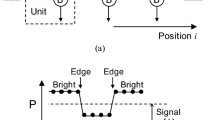Abstract
Basic analog–digital motion detection circuits with low power consumption were proposed based on the vertebrate retina. The motion sensor based on the retina is constructed with a one- or two-dimensional array of the unit circuits. The proposed unit circuit for motion detection is constructed with an analog circuit for photoelectric conversion and the digital circuit for generating the motion signal. The metal oxide semiconductor (MOS) transistors utilized to the analog circuits are operated in the subthreshold region. The analog circuit has the characteristic of the low power consumption. The proposed circuit was evaluated by the simulation program with integrated circuit emphasis (SPICE) with the 0.6 μm complementary metal oxide semiconductor (CMOS) process. The test circuits of basic digital circuits were fabricated with the same process. In the simulation and the experiment, the power supply voltage was set to the low voltage. We found that the digital circuit becomes low power consumption because the MOS transistors was operated in the subthreshold region by setting the low voltage. The proposed circuit is characterized by the simple structure and the low power consumption. In the future, the novel motion detection sensor with low power consumption can be realized by applying the integrated circuits constructed with the array of the proposed unit circuits.








Similar content being viewed by others
References
Mead C (1989) Analog VLSI and Neural Systems. Addition Wesley, Reading
Moini A (1999) Vision chips. Kluwer Academic, Norwell
Liu S, Delbruck T, Indiveri G, Whatley A, Douglas R (2015) Event-based neuromorphic systems. John Wiley & Sons Ltd
Yamada H, Miyashita T, Ohtani M, Nishio K, Yonezu H, Furukawa Y (2001) Signal formation of image-edge motion based on biological retinal networks and implementation into an analog metal-oxide-silicon circuit. Opt Rev 8:336–342
Nishio K, Yonezu H, Furukawa Y (2006) A two-dimensional network of analog circuits for motion detection based on the frog visual system. IEICE Trans Fundam Electron Commun Comput Sci 89:428–438
Ohtani M, Yamada H, Nishio K, Yonezu H, Furukawa Y (2002) Analog LSI implementation of biological direction-selective neurons. Jpn J Appl Phys 41:1409–1416
Liu S, Viretta A (2001) Fly-like visuomotor responses of a robot using a VLSI motion-sensitive chips. Biol Cybern 85:449–457
Liu S (2000) A neuromorphic a VLSI model of global motion processing in the fly. IEEE Trans Circuits Syst II 47:1458–1467
Nishio K, Yasuda T (2014) Simple analog-digital motion detection circuit and its application to mobile robot. Opt Rev 21:243–248
Choo K, Kim Y, Seol J, Wu X, Sylvester D, Blaauw D (2019) Energy-efficient motion-triggered IoT CMOS image sensor with capacitor array-assisted charge-injection SAR ADC. IEEE J Solid-State Circuits 54:2921–2931
Wang W, Covi E, Milozzi A, Farronato M, Ricci S, Shandati C, Pedretti G, Ielmini D (2020) Neuromorphic motion detection and orientation selectivity by volatile resistive switching memories. Adv Intell Syst. https://doi.org/10.1002/aisy.202000224
Zhang Z, Wang S, Liu C, Xie R, Hu W, Zhou P (2022) All-in-one two-dimensional retinomorphic hardware device for motion detection and recognition. Nat Nanotechnol 17:27–32
Ha K, Lee J, Kim J, Baek D (2018) Design of dual-mode local oscillators using CMOS technology for motion detection sensors. Sensors 18:1057
Tsuchiya M, Ogawa S, Sato T (2023) Investigation of low-power consumption of 12-bit time-to-digital converter. In: 2023 Annual Conference of Electronics, Information and Systems Society IEE of Japan, pp 1186–1191
Author information
Authors and Affiliations
Corresponding author
Additional information
Publisher's Note
Springer Nature remains neutral with regard to jurisdictional claims in published maps and institutional affiliations.
This work was presented in part at the joint symposium of the 28th International Symposium on Artificial Life and Robotics, the 8th International Symposium on BioComplexity, and the 6th International Symposium on Swarm Behavior and Bio-Inspired Robotics (Beppu, Oita and Online, January 25–27, 2023).
About this article
Cite this article
Nishio, K., Fukuda, A. Basic analog–digital circuit for motion detection based on the vertebrate retina with low power consumption. Artif Life Robotics 29, 114–119 (2024). https://doi.org/10.1007/s10015-023-00904-9
Received:
Accepted:
Published:
Issue Date:
DOI: https://doi.org/10.1007/s10015-023-00904-9




